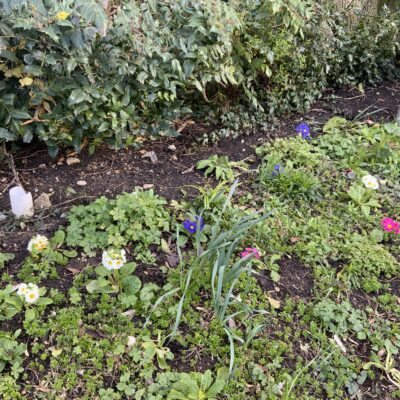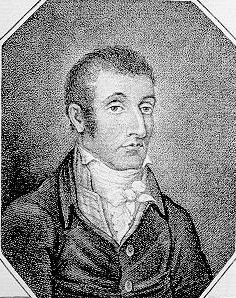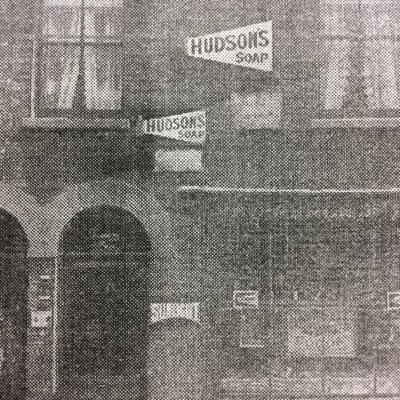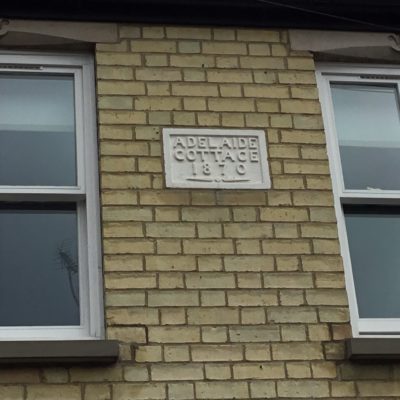Search by topic
- archaeology
- Building of Local Interest
- charity
- church
- crime
- dressmaker
- fire
- Great Eastern Railway
- Listed building
- Mapping Relief
- medieval
- oral history
- poverty
- Public House
- Rattee & Kett
- Religious House
- Roman
- scholar
- school
- Then and Now
- tudor
- women
- work
- world war one
- world war two
Search by text
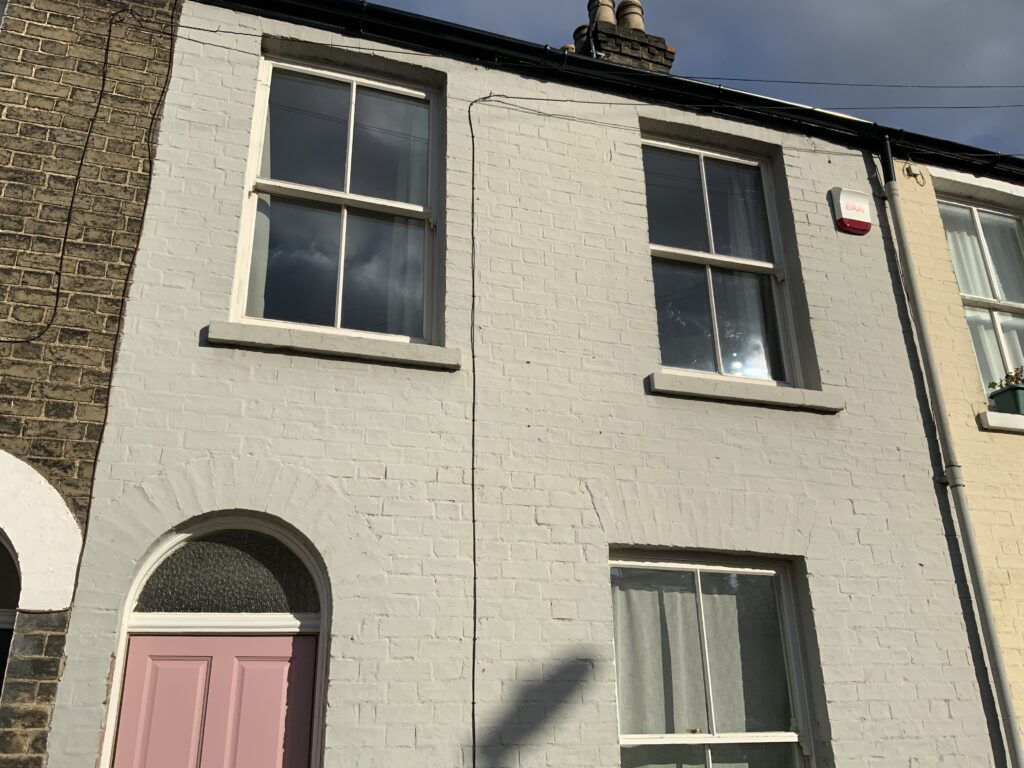
106 Ainsworth Street
106 Ainsworth Street
Number 106 is one of a terrace of five houses on the east side of Ainsworth Street, built around 1870.
1871 census for household 228*
James Ellis, head, 48, boiler maker, b. Liverpool, Lancashire
Rose Ellis, wife, 29, 1842, dressmaker, b. Shepherds Bush, London
James Ellis, son, 20, 1851, boiler maker, b. London, Middlesex
Richard Ellis, son, 16, 1855, errand boy, b. London, Middlesex
Niclous Ellis, son, 16, 1855, errand boy, b. London, Middlesex
*In 1871 Ainsworth Street was not yet numbered. Identification of houses is tentative.
1881 census
Mark Almond, head, 54, engine driver on GER, b. Gt Bentley, Essex
Harriet Almond, wife, 51, b. Wisbech, Cambridgeshire
Florence M Almond, daughter, 17, b. Islington, London
According to deeds for neighbouring properties, Mark Almond owned the terrace of five houses comprising nos. 100 to 108. He was the original property developer of Florence Villa, 23 Hooper Street, and owned the plot of land now numbered 23A and 23B Hooper Street. He sold those properties in 1874 but kept the terrace on Ainsworth Street. Legal documents from 1905, held at Cambridgeshire Archives in Ely (KCB/2/CL/15/25/2), show that the five houses were still owned by Mark’s daughter Florence Mary Allen.
1891 census
John Hills, head, 37, signalman GER, b. Cambridgeshire
Emma Hills, wife, 35, b. Histon, Cambridgeshire
John and Emma Hills married in Chesterton in 1884. The electoral roll shows John at this property from 1890 to 1897. As a signalman for the Great Eastern Railway, John Hills controlled the signals and points to determine the route trains would take.
By 1909 John was a widower, and he married Frances Emily Ogram at St Phillips church. In 1917, aged 60, and having been a signalman all his life, he joined the National Union of Railwaymen.
1901 census
Leonard Savidge, head, 30, police constable, b. Cottenham, Cambridgeshire
Clara Savidge, wife, 31, b. Rampton, Cambridgeshire
William Savidge, son, 4, b. Cambridge
Margaret Savidge, daughter, 2, b. Cambridge
Ann Savidge, daughter, 5 mo, b. Cambridge
1911 census
Leonard Savidge, head, 40, police constable, b. Cottenham, Cambridgeshire
Clara Savidge, wife, 41, b. Rampton, Cambridgeshire
William Savidge, son, 14, telegraph messenger, b. Cambridge
Margaret Savidge, daughter, 12, b. Cambridge
Ann Savidge, daughter, 10, b. Cambridge
Nellie Savidge, daughter, 7, b. Cambridge
Charles Savidge, son, 5, b. Cambridge
Leonard Savidge, son, 2, b. Cambridge
15 years married, 6 children
1921 census
Leonard Savidge, head, 50, police inspector, b. Cottenham, Cambridgeshire
Clara Savidge, wife, 51, b. Rampton, Cambridgeshire
Margaret Savidge, daughter, 22, telephonist, GPO, b. Cambridge
Charles Savidge, son, 15, messenger boy, Christ’s College, b. Cambridge
Leonard Savidge, son, 12, b. Cambridge
Alfred Savidge, son, 8, b. Cambridge
Leonard Savidge and his wife Clara (née Cundell) appear at no. 106 on the 1901, 1911 and 1921 census returns. The electoral register shows them at the property between 1897 and 1922. Leonard and Clara married in 1895.
Leonard Savidge: policeman, sprinter and horticulturalist
In his job as a police constable, Leonard was frequently in the local newspapers. He frequently appeared in court giving evidence against drunks, undergraduates throwing things from windows, people causing obstructions in the street, carriage drivers failing to show lights, illegal parking on Coe Fen, an annoying organ grinder, a man losing control of his pig-float and landlords staying open past closing time.
He was also quite a good runner. August 1899 and it’s the fourth annual Cambridge Borough Police Athletic Festival at the Leys School: ‘This festival has become one of the most popular athletic meetings in Cambridge and is well supported by residents in the borough’ (Cambridge Independent Press, 18 August 1899).
Despite bring the runner to actually break the tape in the 100 yards handicap, it was decided that two other runners had past the line ahead of him. So he came third and won a set of Cambridge beer mugs. However, he did come first in the thread-the-needle contest and won ‘a fancy biscuit jar’!
In 1901 at the 6th Annual Festival he won the 100 Yards Handicap and won a ‘silver mounted glass tankard’ for coming first. The following year he came third and won an ‘electro plated sugar basin’. Then in 1903 he was on the winning tug-of-war team and they all won ‘electro plated and glass butter dishes’.
17 November 1905: ‘It is evident, from what has come to light this week, that the “Rag” with which the King’s Birthday … [was] celebrated in Cambridge, was the most serious that has occurred … both in damage done to property and the violence of the crowd towards the owners who tried to defend their property, and the authorities who sought to restore order.’
There were serious fires on Sheep’s Green and Midsummer Common, where Leonard was positioned. ‘The most serious injury was sustained by P.c. Leonard Savidge, who was struck by half a brick in Emmanuel Street, as he was conveying a prisoner to the Police Station. He fell to the ground, stunned and had to be taken to a surgery, where a cut about an inch and a half long … was attended to.’
The perpetrator was a member of Clare College, but it couldn’t be proved that he threw the brick. So he was fined £20 and costs of £1 12s 6d rather than being sent to prison.
20 May 1907: There was a fight outside The Geldart on Ainsworth Street. ‘P.c. Leonard Savidge stated that he heard of a disturbance outside the “Geldart” publichouse while working on his garden, and on proceeding to the spot he received from Furniss of having been assaulted.’ Herbert Sheffield, 24, was charged with assaulting Edward Furniss of 95 York Street.
11 September 1908: ‘Police Promotions … P.c. Leonard Savidge [has been promoted] to the post of Acting-Sergeant.’ After this date the papers either refer to him as a Police Constable, an Acting Sergeant or a Sergeant.
On 24 August 1910 he was on the Cambridge Borough Police cricket team who went to Bedford to challenge their police force. Leonard was run out and the Bedford team won.
20 June 1913: ‘Fire at Kerridge & Shaw’s. The outbreak was discovered by Mrs Annie Peters of 50 Sturton Street.’ The Central Fire Station was called and some residents ‘Knowing where the hydrant was they immediately set to work to play on the flames, which had broken out in a heap of sawdust and rubbish.’ Police Sergeant Leonard Savidge arrived with the motor-tender and helped to put out the fire.
This wasn’t his first fire: he helped put out a fire behind a confectioners on Petty Cury back in January 1899. Then in September 1915 he helped again with a fire at a builders on Abbey Walk.
In October 1915 is the first mention of him having an allotment. He was at Barnwell Allotments when he observed fireworks in the street. They ‘made a surprisingly loud noise and lit the sky up vividly,’ he stated.
16 May 1917: ‘Watch Committee. An application was received from Police sergeant Leonard Savidge to have his pension secured, and to be placed in the Reserve Class. Agreed that his pension of £1 6s 8d per week be secured, and that he be transferred to the Reserve Class, the pension not to take effect wile he remains in the Police Force.’
24 October 1917: ‘A letter was received from the Mayor offering a cheque value £1 1s for the services of Police Sergeant Leonard Savidge and Acting-Sergeant Pott as Mace Bearers during the Mayor’s year of office, and it was agreed that the offer of the Mayor be accepted with thanks.’ The newspapers report that he was also mace bearer for the Mayor in May 1918 and in November 1919 the formal term ‘Sergeants-at-Mace’ is used.
11 October 1918 and Leonard is back on his allotment winning prizes for his veg. ‘Police Vegetable Show. Potatoes (round) 1. Sergt L Savidge (grown on Barnwell Allotments)’ also ‘Beet (long) … 3. Sergt L Savidge’. The paper didn’t record the allotments for his beets, so they must have been grown in his garden at no. 106.
2 April 1920 ‘Inspector Leonard Savidge a few years ago shone in the police athletic world and is the proud possessor of a very large number of trophies. He was promoted to the rank of Sergeant in 1911, and has always performed his duties faithfully and well.’
There is a photo of him with some colleagues at the Peterborough Show, July 1895 here on British Police History.
He appears in the papers a few more times as a pall bearer at various police funerals, and in 1922 he and Clara left Ainsworth Street. By 1939 he was living at 124 Gwydir Street with his daughter Margaret. Clara died in 1934, and Leonard died in 1946.
Leonard’s children
William Savidge. He married Marjorie Reynolds in 1919,and became a ‘skilled worker telecommunications’ in Berkhamstead. He is mentioned on the probate of his sister Ann’s husband Fritz.
Margaret Savidge. She lived with her father at 124 Gwydir Street until her marriage in 1940 to George Clarke. Her entry on the 1939 register isn’t very clear, but she most likely worked as a telephonist for the Post Office.
Ann Savidge. In 1939 she was working as a housemaid at a property on Hills Road. She became the second wife of Fritz Johann Heinrich Krenkow in 1947. Fritz was an uncle of D H Lawrence.
Nellie Savidge. in 1939 she was living at 35 Hartington Grove working as a housekeeper to an Eleanor Currie who was listed as a ‘Christian Science Practitioner’. Nellie never married.
Charles Savidge. There is a transcription of his obituary here at My Primitive Methodists.
Leonard Savidge. In the summer of 1939 he married Edith Martin. They lived at 150 Scotland Road, where he was a general shop keeper.
Source: 1871–1921 England Census, England & Wales Marriages 1837–2005, Cambridgeshire Marriages, England & Wales, Civil Registration Death Index, 1916–2007, Cambridgeshire, England, Electoral Registers, Burgess Rolls and Poll Books, 1722–1966, 1939 register, Cambridge Daily News 18 January 1899, 24 Oct 1917, 11 Oct 1918, Cambridge Independent Press Aug 1899, Aug 1901, Aug 1903, 17 Nov 1905, 24 May 1907, 11 Sept 1908, 24 Aug 1910, Sept 1915, Oct 1915, 16 May 1917, May 1918, Nov 1919, 2 Apr 1920, British Police History, My Primitive Methodists, InYourArea.co.uk,
Contribute
Do you have any information about the people or places in this article? If so, then please let us know using the Contact page or by emailing capturingcambridge@
License
This work is licensed under CC BY-NC-SA 4.0





